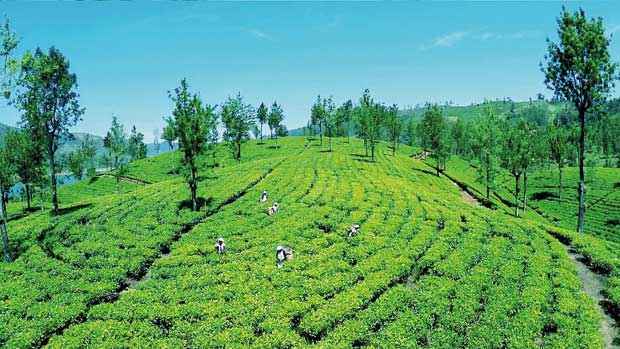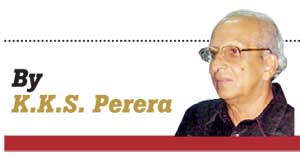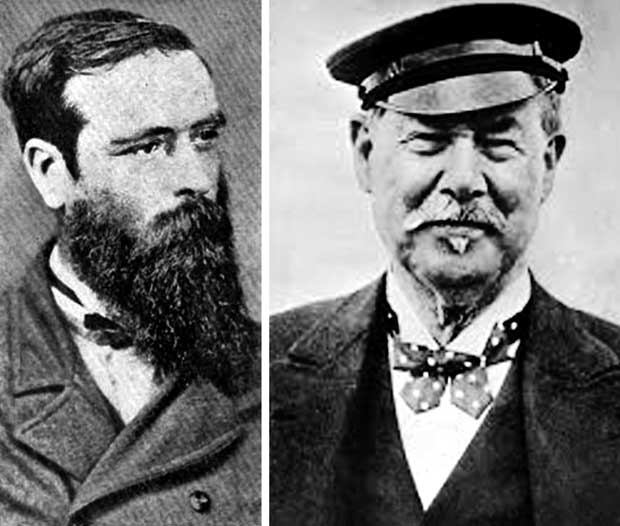Reply To:
Name - Reply Comment
Last Updated : 2024-04-25 00:00:00

Accidentally discovered in 2737 BC by the Chinese Emperor Shen Nung, today, tea is the most popular beverage, next to water with the Americans alone consuming approximately 650 million pounds a day; and over three billion cups are consumed daily worldwide. It was British planter,  James Taylor who, at 17 years started a tea plantation in the 19-acre Loolecondera estate in Kandy and in five years he operated a fully equipped tea factory and the first sale of tea was made in Kandy in 1872. An year later the first shipment of Ceylon tea, a consignment of some 23 lb arrived in London. Today, it has since developed into a $1.6 billion export business for the teardrop shaped island nation.
James Taylor who, at 17 years started a tea plantation in the 19-acre Loolecondera estate in Kandy and in five years he operated a fully equipped tea factory and the first sale of tea was made in Kandy in 1872. An year later the first shipment of Ceylon tea, a consignment of some 23 lb arrived in London. Today, it has since developed into a $1.6 billion export business for the teardrop shaped island nation.
44 years ago, and exactly 100 years after the first consignment of 23 pounds of Ceylon Tea was unloaded in English soil the writer happened to be in England on a visit. Then there was little international cricket and terrorism was in its infancy. Almost every young and old Englishmen to whom he was introduced as a Ceylonese, expressed ignorance, while an odd one exclaimed, “Ah…, that’s where tea come from” or “the first woman Prime Minister’s country?” Our country remained as ‘Lipton’s Tea Estate’ to most of them.
Sri Lanka is the world’s fourth-largest producer of tea. Tea production is one of the main sources of our foreign exchange and accounts for 2% of GDP, and contributed US $1.7 billion to the economy in 2015. Five percent of the population directly or indirectly is involved in the industry. Before Kenya overtook us in the mid-fifties, Sri Lanka was the world’s leading exporter of tea. In the recent pass it recorded a production of 340 million kg, which was the highest so far.
Lipton’s genius was in the marketing and distribution of the final product and his capacity to create and popularize witty slogans was legendary. Though shipped in bulk form, instead of selling it loose, as was the tradition at that time, Lipton sold his tea in well designed eye-catching packets under the slogan “Straight from Ceylonese gardens to the tea pot.” Lipton’s venture into tea was an enormous success. His 300 shops all over England soon could not keep up with the rising demand for his reasonably priced product, and so Lipton teas became popular in other stores around Britain. The name of Lipton became a trademark quickly to be well-known the world-over. Queen Victoria, a great admirer of the Lipton tea brand, in 1897 elevated Thomas Lipton to knighthood.
Even as Sri Lanka became the world’s largest tea exporter in mid-sixties, the industry was still under the control by the British, who exported the tea in bulk form and branded it overseas.
 James Taylor (left) Sir Thomas Lipton (right)
James Taylor (left) Sir Thomas Lipton (right) Early 1970s quite a few local men began dreaming of branding and packaging pure Ceylon tea, leaving out middlemen and generating more profits for island, which officially became known as Sri Lanka in 1972. But was hampered with government introducing two vicious rounds of land reform which delayed those positive steps and nearly wiped out our tea industry, but in 1980s two companies successfully launched their products in value added form, which have become Sri Lanka’s most recognized international brands. Sri Lanka’s packeted tea industry comprised 36 per cent of total exports, which is a resentment of the other major exporters, is dependent on the status of the Ceylon origin, thanks to Thomas Lipton who created the concept—Ceylon TEA.
World Tea Council records say, the 340 million kilograms of tea Sri Lanka exported in 2012, as the third highest by volume behind Kenya and China, and when measured in value terms it achieved the number two position.
The first plant of camellia sinesis brought from China in 1824 by the British, who had colonized the island in 1818 was for display in the Royal Botanical Gardens Peradeniya in the country’s lush central hills.–
There is a Tea Museum located in an abandon Tea Factory in the Hantana hill, a few kilometres West of Kandy, which is fairly popular among tourists but unfortunately only few locals visit the place. There you have the chance of viewing very old machinery used in the production of tea from the times of James Taylor, which is an excellent opportunity for anyone interested in the history or tea. Those who travel to Kandy should visit this Tea Museum which is spread over a few floors— it offers an enthralling insight into this famous beverage. The guide will explain the various stages in the process, though not in working condition, showing you very early types of machinery used in the production. It takes four kgs of fresh leaves to produce one kg of dried tea. You need to spend only an hour and you can also enjoy a free cup of Orange Pekoe - Ceylon’s finest tea.
The first public tea auction took place in 1883 following the establishment of the first broking firm, John Brothers & Co in 1876. It was held under the guidance of the Ceylon Chamber of Commerce. The Colombo Tea Traders’ Association was inaugurated in 1894 and the Tea Research Institute was established in 1925. These institutions facilitated boosting the industry in production and export of quality tea in its early stages.
If we are to maintain and qualify as genuine Ceylon Tea, it must not only be grown, made, and packed entirely in Sri Lanka, but must also obey the rules to strict quality standards laid down and upheld by the Tea Board. Ceylon tea should not be mixed with any of the teas from another origin, as attempted by unscrupulous businessmen and must be completely pure and local. However a new policy has been formulated and presented to the Cabinet Committee on Economic Management by a high-level committee which studied blending of teas in Sri Lanka for the re-export of orthodox teas. According to the committee’s deliberations there are both risks and opportunities associated with a further liberalisation of the existing policy.
Teas that qualify to meet above standards may display the trademark Lion; a sword-wielding lion depicting the bravery of a lion on the Sri Lankan national flag. Sri Lanka is uniquely positioned, with close proximity to the equator that ensures a year round supply unlike in India and China. This has resulted in the ability to produce finest quality conventional black tea with the capability to acquire a quality over other origins.
When the country changed its name from Ceylon to Sri Lanka in 1972, the tea industry struggled successfully to keep the widely-recognized name for its tea. Ceylon Tea has unique Characteristics being grown in seven regions spanning three levels of altitudes; Sri Lanka’s tea is Strong, dark, flavourful, complex, citrus and spicy as words frequently used to describe it.
Days of Liptons are forgotten since Unilevers bought over the company. But we are grateful to the entrepreneur, Sir Thomas Lipton for his untiring efforts and the slogan “Straight from Ceylonese gardens to the tea pot.” Today it’s Sri Lankan tea that they consume all over Europe and the States. The limited availability of the product, together with enhanced demand from our markets, prices have gone up further during the first quarter of 2017; in fact it had hit the zenith, though the total value of exports in terms of US$ has come down.
The writer’s son, unlike his father, did not experience any embarrassments in identifying himself as a Sri Lankan in England. But faced pleasant dimness returning on holiday when all his English friends were reminding him, “please do not forget some D…. tea” a particular brand of locally value-added tea which is extremely popular there.
“The Paradise Island, sun and rain Ceylon, presents the perfect climatic conditions for growing of tea. Sri Lanka brought a new dimension to tea by creating variations in quality, taste, character and appearance. Our tea with its distinct taste and quality has now turned out to be every consumer’s favourite cuppa. The British cleared the high grounds of traditional farming population and planted coffee, tea and rubber. They imported large numbers of south Indian Tamils as labourers to work in the plantations, who rapidly made up 7% of the country’s population. However, Line-rooms on the tea estates are dirty and unhealthy, congested, with no ventillation and lighting, soggy and cold with leaking roofs. Toilets blocked or broken. Each room is12 by 10 feet, and is built like barracks in two double rows, accommodating 24 houses—one family occupying a room.The open drains unlined and clogged with effluent, cesspits overflowing into the living areas; a huge backlog of repairs unattended. Appalling conditions and low pay on tea plantations has been the order of the day until recently.”
Very high levels of malnutrition makes tea workers and their families vulnerable to diseases caused by unhygienic living conditions. The inhumane and abusive conditions were endemic throughout the industry.
The exclusion of the estate labour from the state health service as in colonial times, the companies continue with substandard medical practitioners called Estate Medical Assistants (EMA), who have only the pharmacist’s certificate and a special test. They are trained in private hospitals, which lack proper standards.

Add comment
Comments will be edited (grammar, spelling and slang) and authorized at the discretion of Daily Mirror online. The website also has the right not to publish selected comments.
Reply To:
Name - Reply Comment
US authorities are currently reviewing the manifest of every cargo aboard MV
On March 26, a couple arriving from Thailand was arrested with 88 live animal
According to villagers from Naula-Moragolla out of 105 families 80 can afford
Is the situation in Sri Lanka so grim that locals harbour hope that they coul